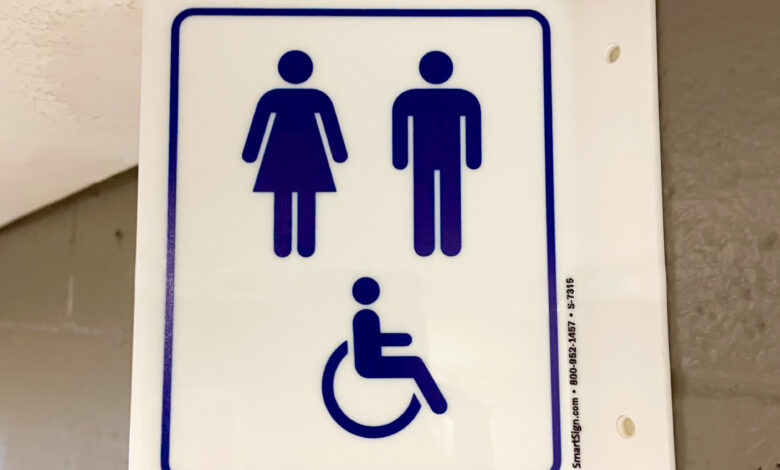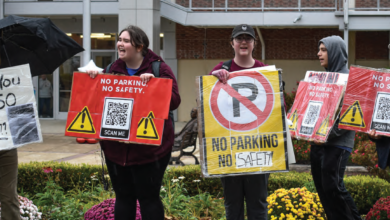
Gender-inclusive bathrooms limited on campus
By Jay Roberson
Rider aims to build an inclusive campus that supports all people, but some transgender students and students with disabilities feel that promise is not being met.
According to Rider’s Center for Diversity and Inclusion’s resources, a majority of buildings have gender-inclusive bathrooms except for the Student Recreation Center, Lynch Adler, Daly Dining Hall and the Joseph P. Vona Center.
Fine Arts bathrooms
Freshman psychology major Adrienne Bishop, a transgender woman, often avoids using the bathroom when in class. A majority of her classes take place in the Fine Arts building where there is only one gender-inclusive bathroom, located on the first floor.
“It’s a pain if you need to use [the bathroom] and you’re in a class, then go there between classes when you only have five minutes left and you don’t know if you have enough time to make the trip,” said Bishop.
Eden Lewis, a non-binary sophomore English major, who uses she/they pronouns, said they felt most gender-inclusive bathrooms were “hidden.”
“In the times where I’ve been in the business building and had to use the [gender-inclusive bathrooms] upstairs, they were really hard to find and that was really the issue,” said Lewis. “There’s a sign next to it, but nothing else really tells you that it’s a bathroom.”
Other institutions, such as the University of Oregon, offer gender-inclusive bathrooms, gender inclusive locker rooms and signage directing students to gender-inclusive bathrooms. Gender-inclusive locker rooms are not offered and gender-inclusive bathrooms are often secluded at Rider.
A majority of the dorms do not have gender-inclusive bathrooms with showers, except Kroner Residence Hall. Bishop explained this can lead to health hazards because transgender students may not feel comfortable showering in bathrooms with an assigned gender.
“I have a friend who’s a transgender man. He used to live in Ziegler and he felt really uncomfortable using either shower, so he would go to Kroner and shower in Kroner because he had friends there,” said Bishop.
To make dorm halls more gender-inclusive, Lewis suggested, “At least one [bathroom] per floor of a building, just so the people who live on those floors can actually have a bathroom to go to that they feel comfortable using.”
‘Killing two birds with one stone’
When these gender-inclusive bathrooms double as accessible bathrooms, it limits resources for both communities.
Junior journalism major Marlene Brockington, who is physically disabled, spoke about her experiences in the Fine Arts building, where most of her classes take place.
“Last semester, myself and another student who has a physical disability had to wait for each other or change up our schedules a little bit,” said Brockington.
Finding time to use the bathroom between classes is a struggle for students who are transgender and students with disabilities.
Junior political science major and chair of equity and inclusion committee Cecelia Simon said, “The bathroom gets swamped sometimes.”
“Having two separate bathrooms would be better because it allows people who need the bathroom for accessibility reasons to access the bathroom freely, whereas putting two groups in the same space can create some awkward situations because it’s the only bathrooms both groups can use,” said Simon.
Senior theater major Andy White, who identifies as non-binary and uses they/them pronouns, said that the upkeep of bathrooms is a problem for transgender students as well.
“The maintenance is slacking. For example, the other week the entire toilet paper holder was on the ground for three or four days with no toilet paper … It just wasn’t usable,” said White.
Brockington also noted that although some bathrooms may say they’re accessible, they aren’t, which limits her to the use of only one bathroom in Fine Arts.
“Even the bathrooms that have the accessible sign, they might have a stall that’s accessible in there, but when you go to wash your hands…a lot of the sinks aren’t accessible because they have a cabinet underneath where somebody with a wheelchair can’t pull underneath it,” said Brockington.
Lewis said, “You could argue that it’s killing two birds with one stone, but at the same time it feels lazy. They’ll put money into various other things, but it’s like ‘Oh, we can just put those two things together.’”
The facilities vice chair, sophomore communications major Justin Getzoff, stated that facilities is aware of this issue and hopes to install more gender-inclusive bathrooms in the next few years.
Bishop said, “The issue is that you’re putting these two groups who need these facilities in the same space and you’re saying, alright well, we can only serve one of you at a time. So figure it out. How do you do that?”
Students can use the CDI’s resources on Rider’s website to see a map of where gender-inclusive bathrooms are located in each building under LGBTQIA+ resources.


